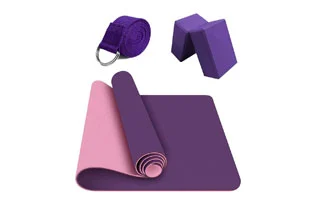Not all yoga mats are created equal. The key things to keep in mind when purchasing a mat are grip, thickness, material, and size—not to mention your preferred workout routine. For example, if you're an advanced yogi who likes the feeling of being rooted to the floor, you'll want a thinner mat. Recovering from an old knee injury? Choose a mat with extra cushioning to protect your pressure points; we recommend a thickness of at least 5mm.
Our favorite feature of the mat is that it's reversible, with a smooth, sticky polyurethane coating on top and a textured natural rubber bottom for tons of traction. Beyond that, though, we also like that this pad is slightly larger and offers plenty of cushioning thanks to its 5mm thickness.
While the Manduka Eko Superlite Travel Yoga Mat's ultra-thin, extremely foldable nature is attractive on its own (especially for frequent travelers), it's also our favorite zero-slip option, with excellent grip and Complete floor stability. As if this news wasn't good enough, the mat is also completely eco-friendly, made from biodegradable natural tree rubber.
Gaiam's Premium Yoga Mat is the best thick yoga mat as the PVC (also known as polyvinyl chloride synthetic rubber) mat has a 6mm cushion and is deeply textured to ensure a non-slip surface. As one of the cheapest mats we tested, it also gets bonus points for being the most affordable yoga mat.
Regular hot yoga practitioners can definitely rely on the Manduka Pro Yoga Mat 6MM to withstand the intense sweat generated during a sweltering class. The PVC mat is so dense that its weight keeps it firmly anchored to the floor, while its ultra-sticky top surface features a state-of-the-art texture that provides non-slip grip - yes, even if you drip with floor sweat.
The Dolphin Yoga Mat shows users exactly where they should place their hands and feet, so beginners will be set up for success as the best company for yoga mat. As a navigational tool of sorts, markers are especially useful for beginners practicing at home without a live instructor available to correct their form. Different types, sizes, colors and styles can be customized.
While travel may not be part of our current agenda, it's certainly something we're all hoping to achieve in the near future, if you're someone who likes to do yoga on the go - or someone who lives in a small space and wants something that can be done easily Stowable Yoga Mat - Dolphin 3210642 Yoga Mat is your best choice.
In terms of cushioning, there's not a lot here, which is to be expected from an ultraportable mat (and why it doesn't capture our overall winning point). If you like foam pads with extra padding, this is not the choice for you. But many advanced yogis prefer thinner mats because they provide greater stability, especially when practicing more active or focused poses.

Yoga mat is an essential tool in yoga practice. A good yoga mat can make your yoga practice more comfortable and safer. However, there are many types of yoga mats on the market with varying quality. How to choose a good yoga mat? Here are some practical suggestions.
1. Material: There are three main materials for yoga mats: PVC, TPE and natural rubber. Among them, yoga mats made of PVC are relatively low-priced, but may contain harmful substances; yoga mats made of TPE are softer and more elastic, and the price is moderate; yoga mats made of natural rubber are the most environmentally friendly, but the price is higher .
2. Thickness: The thickness of yoga mats is generally between 5mm-10mm. Thinner yoga mats are suitable for beginners and people doing low-intensity yoga practices, and thicker yoga mats are suitable for people doing high-intensity yoga practices.
3. Size: Yoga mats generally come in three sizes: 173cmx61cm, 183cmx61cm and 183cmx80cm. When choosing a yoga mat, you should choose it based on your height and yoga practice habits.
4. Anti-slip: A good yoga mat should have good anti-slip and can remain stable during practice. You can test the slip resistance of your yoga mat by applying soapy water to your palms.
5. Durability: The service life of a yoga mat is related to its quality and material. Generally speaking, yoga mats made of natural rubber are the most durable, followed by yoga mats made of TPE, and finally yoga mats made of PVC.
6. Brand: Choosing a well-known brand of yoga mat can ensure product quality and after-sales service.
In general, when choosing a good yoga mat from Yiwu sports market, you need to consider factors such as material, thickness, size, slip resistance, and durability. Hopefully, the above tips will help you choose a yoga mat that’s right for you.